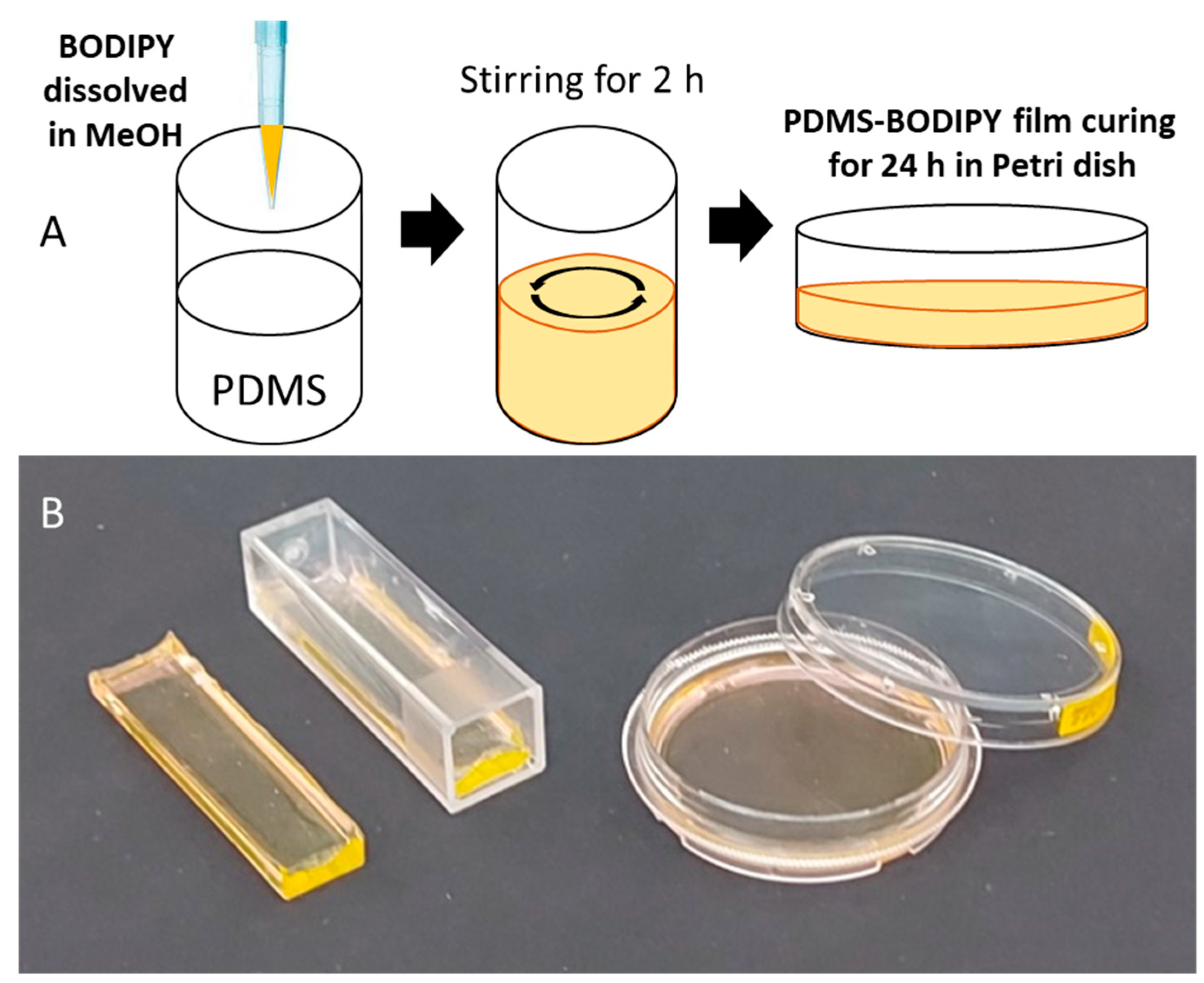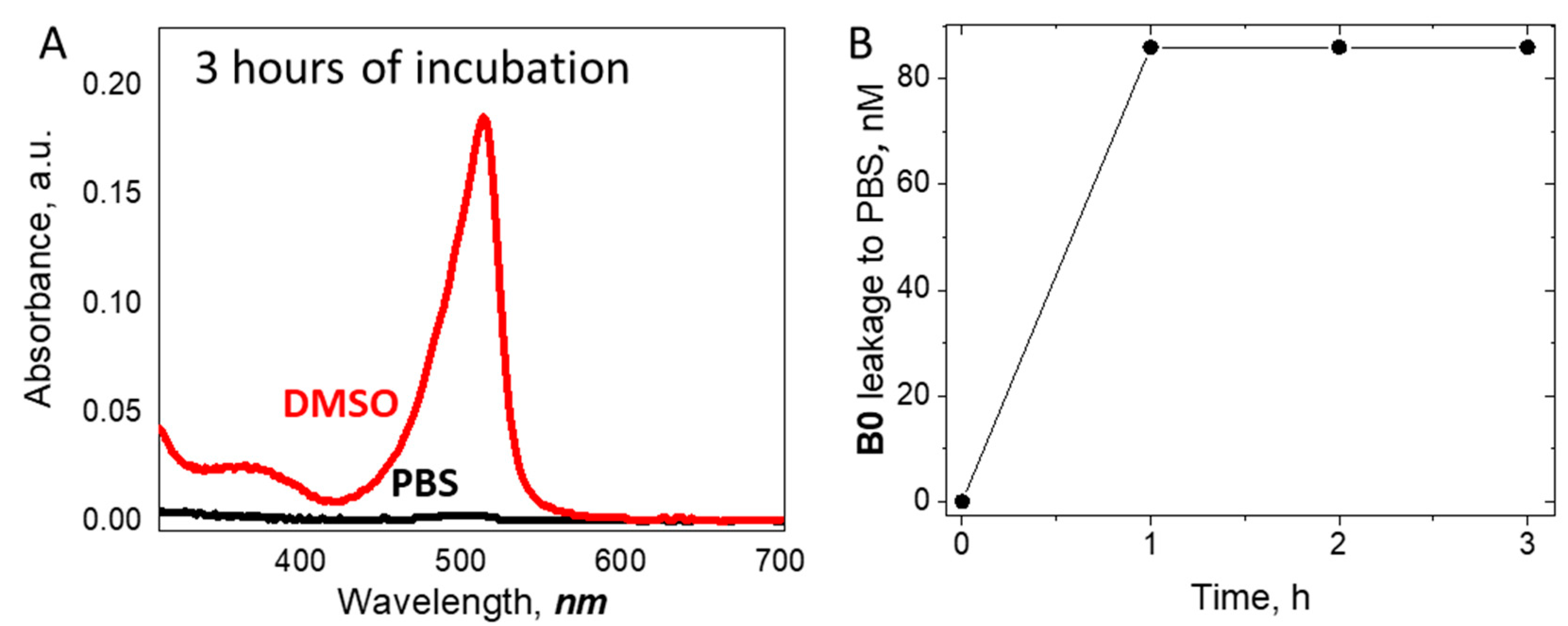Nitric Oxide Photorelease from Silicone Films Doped with N-Nitroso BODIPY
Abstract
:1. Introduction
2. Materials and Methods
3. Results and Discussion
4. Conclusions
Author Contributions
Funding
Data Availability Statement
Acknowledgments
Conflicts of Interest
References
- Vallance, P. Nitric Oxide: Therapeutic Opportunities. Fundam. Clin. Pharmacol. 2003, 17, 1–10. [Google Scholar] [CrossRef]
- Levine, A.B.; Punihaole, D.; Levine, T.B. Characterization of the Role of Nitric Oxide and Its Clinical Applications. Cardiology 2012, 122, 55–68. [Google Scholar] [CrossRef] [PubMed]
- Carpenter, A.W.; Schoenfisch, M.H. Nitric Oxide Release: Part II. Therapeutic Applications. Chem. Soc. Rev. 2012, 41, 3742–3752. [Google Scholar] [CrossRef] [PubMed]
- Thomas, D.D. Breathing New Life into Nitric Oxide Signaling: A Brief Overview of the Interplay between Oxygen and Nitric Oxide. Redox Biol. 2015, 5, 225–233. [Google Scholar] [CrossRef] [PubMed]
- Kang, E.B.; Lee, G.B.; In, I.; Park, S.Y. pH-Sensitive Fluorescent Hyaluronic Acid Nanogels for Tumor-Targeting and Controlled Delivery of Doxorubicin and Nitric Oxide. Eur. Polym. J. 2018, 101, 96–104. [Google Scholar] [CrossRef]
- Zhang, Y.; Yang, J.; Meng, T.; Qin, Y.; Li, T.; Fu, J.; Yin, J. Nitric Oxide-Donating and Reactive Oxygen Species-Responsive Prochelators Based on 8-Hydroxyquinoline as Anticancer Agents. Eur. J. Med. Chem. 2021, 212, 113153. [Google Scholar] [CrossRef]
- Hirst, D.; Robson, T. Targeting Nitric Oxide for Cancer Therapy. J. Pharm. Pharmacol. 2007, 59, 3–13. [Google Scholar] [CrossRef]
- Feng, T.; Wan, J.; Li, P.; Ran, H.; Chen, H.; Wang, Z.; Zhang, L. A Novel NIR-Controlled NO Release of Sodium Nitroprusside-Doped Prussian Blue Nanoparticle for Synergistic Tumor Treatment. Biomaterials 2019, 214, 119213. [Google Scholar] [CrossRef]
- Islam, W.; Fang, J.; Imamura, T.; Etrych, T.; Subr, V.; Ulbrich, K.; Maeda, H. Augmentation of the Enhanced Permeability and Retention Effect with Nitric Oxide-Generating Agents Improves the Therapeutic Effects of Nanomedicines. Mol. Cancer Ther. 2018, 17, 2643–2653. [Google Scholar] [CrossRef]
- Lautner, G.; Stringer, B.; Brisbois, E.J.; Meyerhoff, M.E.; Schwendeman, S.P. Controlled Light-Induced Gas Phase Nitric Oxide Release from S-Nitrosothiol-Doped Silicone Rubber Films. Nitric Oxide Biol. Chem. 2019, 86, 31–37. [Google Scholar] [CrossRef]
- Cardozo, V.F.; Lancheros, C.A.C.; Narciso, A.M.; Valereto, E.C.S.; Kobayashi, R.K.T.; Seabra, A.B.; Nakazato, G. Evaluation of Antibacterial Activity of Nitric Oxide-Releasing Polymeric Particles against Staphylococcus Aureus and Escherichia Coli from Bovine Mastitis. Int. J. Pharm. 2014, 473, 20–29. [Google Scholar] [CrossRef] [PubMed]
- Pelegrino, M.T.; Pieretti, J.C.; Nakazato, G.; Gonçalves, M.C.; Moreira, J.C.; Seabra, A.B. Chitosan Chemically Modified to Deliver Nitric Oxide with High Antibacterial Activity. Nitric Oxide Biol. Chem. 2021, 106, 24–34. [Google Scholar] [CrossRef]
- Estes, L.M.; Singha, P.; Singh, S.; Sakthivel, T.S.; Garren, M.; Devine, R.; Brisbois, E.J.; Seal, S.; Handa, H. Characterization of a Nitric Oxide (NO) Donor Molecule and Cerium Oxide Nanoparticle (CNP) Interactions and Their Synergistic Antimicrobial Potential for Biomedical Applications. J. Colloid Interface Sci. 2021, 586, 163–177. [Google Scholar] [CrossRef]
- Fang, F.C. Perspectives Series: Host/Pathogen Interactions. Mechanisms of Nitric Oxide-Related Antimicrobial Activity. J. Clin. Investig. 1997, 99, 2818–2825. [Google Scholar] [CrossRef]
- Seabra, A.B.; Pelegrino, M.T.; Haddad, P.S. Chapter 9-Can Nitric Oxide Overcome Bacterial Resistance to Antibiotics? In Antibiotic Resistance; Kon, K., Rai, M., Eds.; Academic Press: Cambridge, MA, USA, 2016; pp. 187–204. ISBN 978-0-12-803642-6. [Google Scholar]
- Williams, D.L.H. Nitric Oxide Release from S-Nitrosothiols (RSNO)-the Role of Copper Ions. Transit. Met. Chem. 1996, 21, 189–191. [Google Scholar] [CrossRef]
- Chipinda, I.; Simoyi, R.H. Formation and Stability of a Nitric Oxide Donor: S-Nitroso-N-Acetylpenicillamine. J. Phys. Chem. B 2006, 110, 5052–5061. [Google Scholar] [CrossRef]
- Wood, P.D.; Mutus, B.; Redmond, R.W. The Mechanism of Photochemical Release of Nitric Oxide from S-Nitrosoglutathione. Photochem. Photobiol. 1996, 64, 518–524. [Google Scholar] [CrossRef]
- Okuno, H.; Ieda, N.; Hotta, Y.; Kawaguchi, M.; Kimura, K.; Nakagawa, H. A Yellowish-Green-Light-Controllable Nitric Oxide Donor Based on N-Nitrosoaminophenol Applicable for Photocontrolled Vasodilation. Org. Biomol. Chem. 2017, 15, 2791–2796. [Google Scholar] [CrossRef] [PubMed]
- Ieda, N.; Oka, Y.; Yoshihara, T.; Tobita, S.; Sasamori, T.; Kawaguchi, M.; Nakagawa, H. Structure-Efficiency Relationship of Photoinduced Electron Transfer-Triggered Nitric Oxide Releasers. Sci. Rep. 2019, 9, 1430. [Google Scholar] [CrossRef]
- He, H.; Xia, Y.; Qi, Y.; Wang, H.-Y.; Wang, Z.; Bao, J.; Zhang, Z.; Wu, F.-G.; Wang, H.; Chen, D.; et al. A Water-Soluble, Green-Light Triggered, and Photo-Calibrated Nitric Oxide Donor for Biological Applications. Bioconjug. Chem. 2018, 29, 1194–1198. [Google Scholar] [CrossRef]
- Sodano, F.; Gazzano, E.; Fraix, A.; Rolando, B.; Lazzarato, L.; Russo, M.; Blangetti, M.; Riganti, C.; Fruttero, R.; Gasco, A.; et al. A Molecular Hybrid for Mitochondria-Targeted NO Photodelivery. ChemMedChem 2018, 13, 87–96. [Google Scholar] [CrossRef] [PubMed]
- Ieda, N.; Hotta, Y.; Yamauchi, A.; Nishikawa, A.; Sasamori, T.; Saitoh, D.; Kawaguchi, M.; Kimura, K.; Nakagawa, H. Development of a Red-Light-Controllable Nitric Oxide Releaser to Control Smooth Muscle Relaxation In Vivo. ACS Chem. Biol. 2020, 15, 2958–2965. [Google Scholar] [CrossRef]
- Zhang, Z.; Luo, X.; Yang, Y. From Spontaneous to Photo-Triggered and Photo-Calibrated Nitric Oxide Donors. Isr. J. Chem. 2021, 61, 159–168. [Google Scholar] [CrossRef]
- Fraix, A.; Parisi, C.; Seggio, M.; Sortino, S. Nitric Oxide Photoreleasers with Fluorescent Reporting. Chem.–Eur. J. 2021, 27, 12714–12725. [Google Scholar] [CrossRef] [PubMed]
- Knoblauch, R.; Geddes, C.D. Plasmonic Enhancement of Nitric Oxide Generation. Nanoscale 2021, 13, 12288–12297. [Google Scholar] [CrossRef] [PubMed]
- Lu, H.; Shen, Z. Editorial: BODIPYs and Their Derivatives: The Past, Present and Future. Front. Chem. 2020, 8, 290. [Google Scholar] [CrossRef] [PubMed]
- Ieda, N.; Hotta, Y.; Miyata, N.; Kimura, K.; Nakagawa, H. Photomanipulation of Vasodilation with a Blue-Light-Controllable Nitric Oxide Releaser. J. Am. Chem. Soc. 2014, 136, 7085–7091. [Google Scholar] [CrossRef] [PubMed]
- Parisi, C.; Failla, M.; Fraix, A.; Rolando, B.; Gianquinto, E.; Spyrakis, F.; Gazzano, E.; Riganti, C.; Lazzarato, L.; Fruttero, R.; et al. Fluorescent Nitric Oxide Photodonors Based on BODIPY and Rhodamine Antennae. Chem.–Eur. J. 2019, 25, 11080–11084. [Google Scholar] [CrossRef] [PubMed]
- Parisi, C.; Failla, M.; Fraix, A.; Rescifina, A.; Rolando, B.; Lazzarato, L.; Cardile, V.; Graziano, A.C.E.; Fruttero, R.; Gasco, A.; et al. A Molecular Hybrid Producing Simultaneously Singlet Oxygen and Nitric Oxide by Single Photon Excitation with Green Light. Bioorg. Chem. 2019, 85, 18–22. [Google Scholar] [CrossRef]
- Lazzarato, L.; Gazzano, E.; Blangetti, M.; Fraix, A.; Sodano, F.; Picone, G.M.; Fruttero, R.; Gasco, A.; Riganti, C.; Sortino, S. Combination of PDT and NOPDT with a Tailored BODIPY Derivative. Antioxidants 2019, 8, 531. [Google Scholar] [CrossRef]
- Panfilov, M.; Karogodina, T.; Sibiryakova, A.; Tretyakova, I.; Vorob’ev, A.; Moskalensky, A. Meso-Aminomethyl-BODIPY as a Scaffold for Nitric Oxide Photo-Releasers. ChemistrySelect 2023, 8, e202302681. [Google Scholar] [CrossRef]
- Zhermolenko, E.O.; Karogodina, T.Y.; Vorobev, A.Y.; Panfilov, M.A.; Moskalensky, A.E. Photocontrolled Release of Nitric Oxide for Precise Management of NO Concentration in a Solution. Mater. Today Chem. 2023, 29, 101445. [Google Scholar] [CrossRef]
- Tricker, A.R.; Preussmann, R. Carcinogenic N-Nitrosamines in the Diet: Occurrence, Formation, Mechanisms and Carcinogenic Potential. Mutat. Res. 1991, 259, 277–289. [Google Scholar] [CrossRef] [PubMed]
- Mowery, K.A.; Meyerhoff, M.E. The Transport of Nitric Oxide through Various Polymeric Matrices. Polymer 1999, 40, 6203–6207. [Google Scholar] [CrossRef]
- Frost, M.C.; Meyerhoff, M.E. Controlled Photoinitiated Release of Nitric Oxide from Polymer Films Containing S-Nitroso-N-Acetyl-DL-Penicillamine Derivatized Fumed Silica Filler. J. Am. Chem. Soc. 2004, 126, 1348–1349. [Google Scholar] [CrossRef] [PubMed]
- Gierke, G.E.; Nielsen, M.; Frost, M.C. S-Nitroso-N-Acetyl-D-Penicillamine Covalently Linked to Polydimethylsiloxane (SNAP-PDMS) for Use as a Controlled Photoinitiated Nitric Oxide Release Polymer. Sci. Technol. Adv. Mater. 2011, 12, 055007. [Google Scholar] [CrossRef] [PubMed]
- Sun, J.; Zhang, X.; Broderick, M.; Fein, H. Measurement of Nitric Oxide Production in Biological Systems by Using Griess Reaction Assay. Sensors 2003, 3, 276–284. [Google Scholar] [CrossRef]
- Green, L.C.; Wagner, D.A.; Glogowski, J.; Skipper, P.L.; Wishnok, J.S.; Tannenbaum, S.R. Analysis of Nitrate, Nitrite, and [15N]Nitrate in Biological Fluids. Anal. Biochem. 1982, 126, 131–138. [Google Scholar] [CrossRef]
- APPLICATION NOTE AAN 105-03. Designing a Potentiostatic Circuit. Available online: https://www.alphasense.com/wp-content/uploads/2022/10/AAN_105-03_App-Note_V0.pdf (accessed on 30 June 2023).
- Dryden, M.D.M.; Wheeler, A.R. DStat: A Versatile, Open-Source Potentiostat for Electroanalysis and Integration. PLoS ONE 2015, 10, e0140349. [Google Scholar] [CrossRef]
- Shrestha, P.; Dissanayake, K.; Gehrmann, E.; Wijesooriya, C.; Mukhopadhyay, A.; Smith, E.; Winter, A. Efficient Far-Red/Near-IR Absorbing BODIPY Photocages by Blocking Unproductive Conical Intersections. J. Am. Chem. Soc. 2020, 142, 15505–15512. [Google Scholar] [CrossRef]
- Parisi, C.; Longobardi, G.; Graziano, A.C.E.; Fraix, A.; Conte, C.; Quaglia, F.; Sortino, S. A Molecular Dyad Delivered by Biodegradable Polymeric Nanoparticles for Combined PDT and NO-PDT in Cancer Cells. Bioorg. Chem. 2022, 128, 106050. [Google Scholar] [CrossRef] [PubMed]
- Sortino, S.; Parisi, C.; Seggio, M.; Fraix, A. A High-Performing Metal-Free Photoactivatable NO Donor with a Green Fluorescent Reporter. ChemPhotoChem 2020, 9, 742–748. [Google Scholar] [CrossRef]
- Enayati, M.; Schneider, K.H.; Almeria, C.; Grasl, C.; Kaun, C.; Messner, B.; Rohringer, S.; Walter, I.; Wojta, J.; Budinsky, L.; et al. S-Nitroso Human Serum Albumin as a Nitric Oxide Donor in Drug-Eluting Vascular Grafts: Biofunctionality and Preclinical Evaluation. Acta Biomater. 2021, 134, 276–288. [Google Scholar] [CrossRef] [PubMed]
- Knoblauch, R.; Harvey, A.; Ra, E.; Greenberg, K.M.; Lau, J.; Hawkins, E.; Geddes, C.D. Antimicrobial carbon nanodots: Photodynamic inactivation and dark antimicrobial effects on bacteria by brominated carbon nanodots. Nanoscale 2021, 13, 12288. [Google Scholar] [CrossRef] [PubMed]
- Vayalakkara, R.K.; Lo, C.L.; Chen, H.H.; Shen, M.Y.; Yang, Y.C.; Sabu, A.; Huang, Y.F.; Chiu, H.C. Photothermal/NO combination therapy from plasmonic hybrid nanotherapeutics against breast cancer. J. Control. Release 2022, 345, 417–432. [Google Scholar] [CrossRef]
- Kniazev, K.I.; Yakunenkov RE, E.; Zulina NY, A.; Fokina, M.I.; Nabiullina, R.D.; Toropov, N.A. The Effect of Localized Plasmons in Silver and Gold Thin Films on the Optical Properties of Organic Dyes in an Acrylate Polymer Matrix. Opt. Spectrosc. 2018, 125, 578–581. [Google Scholar] [CrossRef]





| λmax, nm | ε, M−1 cm−1 | ||
|---|---|---|---|
| EtOH | B0 | 512 | 57,100 |
| B1 | 517 | 72,100 | |
| PDMS | B0 | 514 | 54,400 |
| B1 | 517 | 56,500 |
Disclaimer/Publisher’s Note: The statements, opinions and data contained in all publications are solely those of the individual author(s) and contributor(s) and not of MDPI and/or the editor(s). MDPI and/or the editor(s) disclaim responsibility for any injury to people or property resulting from any ideas, methods, instructions or products referred to in the content. |
© 2024 by the authors. Licensee MDPI, Basel, Switzerland. This article is an open access article distributed under the terms and conditions of the Creative Commons Attribution (CC BY) license (https://creativecommons.org/licenses/by/4.0/).
Share and Cite
Virts, N.A.; Karogodina, T.Y.; Panfilov, M.A.; Vorob’ev, A.Y.; Moskalensky, A.E. Nitric Oxide Photorelease from Silicone Films Doped with N-Nitroso BODIPY. J. Funct. Biomater. 2024, 15, 92. https://doi.org/10.3390/jfb15040092
Virts NA, Karogodina TY, Panfilov MA, Vorob’ev AY, Moskalensky AE. Nitric Oxide Photorelease from Silicone Films Doped with N-Nitroso BODIPY. Journal of Functional Biomaterials. 2024; 15(4):92. https://doi.org/10.3390/jfb15040092
Chicago/Turabian StyleVirts, Natalia A., Tatyana Yu. Karogodina, Mikhail A. Panfilov, Alexey Yu. Vorob’ev, and Alexander E. Moskalensky. 2024. "Nitric Oxide Photorelease from Silicone Films Doped with N-Nitroso BODIPY" Journal of Functional Biomaterials 15, no. 4: 92. https://doi.org/10.3390/jfb15040092






